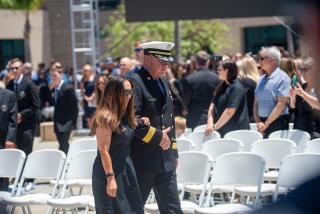Order to Delay Blast on ‘Twilight’ Set Told
- Share via
Minutes before the fatal helicopter accident on the “Twilight Zone” film set, special-effects coordinator Paul Stewart met with two technicians and ordered them not to ignite their explosives until the helicopter was a safe distance away, technician Jerry Williams testified Wednesday during cross-examination.
According to Williams, both he and technician James Camomile were ordered by Stewart “to look . . . and make sure that nothing is in danger” before firing the explosives, two of which had been placed under structures in a mock Vietnamese village.
Stewart, director John Landis and three associates are charged with involuntary manslaughter in the deaths of actor Vic Morrow and two child actors who were killed when the helicopter--struck by a fireball caused by the explosives--plummeted out of the air and crashed upon them.
Prosecutors contend that the defendants acted negligently in undertaking the film shot. The defense counters that the accident was an unforeseeable tragedy that occurred because Camomile inadvertently fired his explosives before the low-flying helicopter was safely out of the way.
Camomile, considered a key witness by the defense even though he will be called by the prosecution, is scheduled to testify next week. Williams, who spent the full day on the witness stand, was not allowed by Superior Court Judge Roger W. Boren to answer defense questions about what Camomile later told him about Camomile’s role in the accident.
Williams did say, however, that he thought as the accident was occurring that Camomile, who has been given immunity by the prosecution, either “slipped” or shot off his explosives too rapidly.
Williams also shed new light on his previous testimony that Stewart ordered him to place an explosive under a structure in the village even though Stewart and Landis had decided earlier that explosives in the mock huts could shower debris and cripple the helicopter.
Williams said he thought it was safe to place the explosive there because it was built differently than other structures on the set--with no side walls, no metal roof and a floor more than three feet off the ground.
Williams added that “there is an inherent danger” in all special-effects work but that he did not think the fatal scene would prove dangerous because of precautions that had been taken.
The special-effects veteran also charged that when he was interviewed two months after the 1982 accident by county sheriff’s investigators, they hinted that they might try to lift his state license unless he changed his testimony concerning explosives on the film set. The lead investigator, Sheriff’s Sgt. Thomas Budds, reserved comment on that charge until he is called to testify.
More to Read
Only good movies
Get the Indie Focus newsletter, Mark Olsen's weekly guide to the world of cinema.
You may occasionally receive promotional content from the Los Angeles Times.










